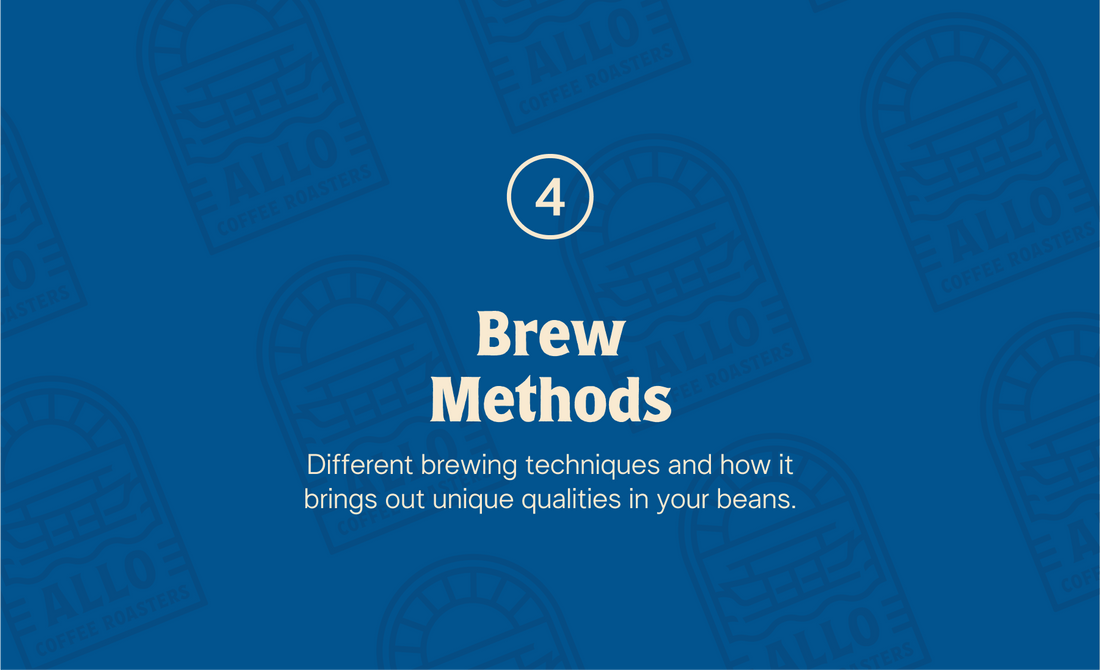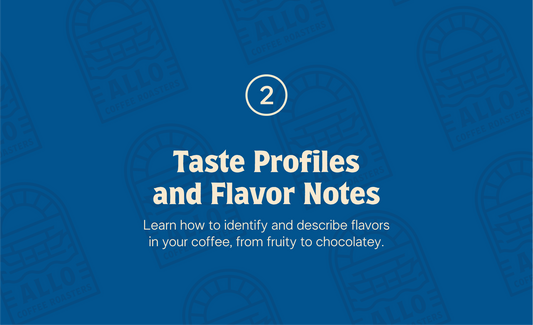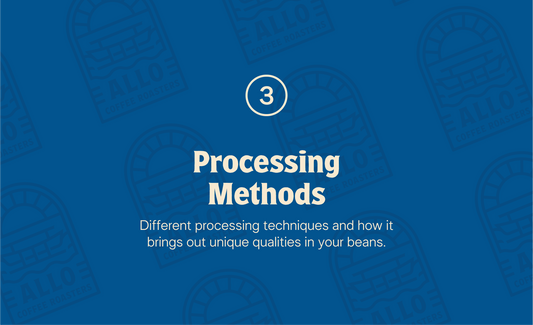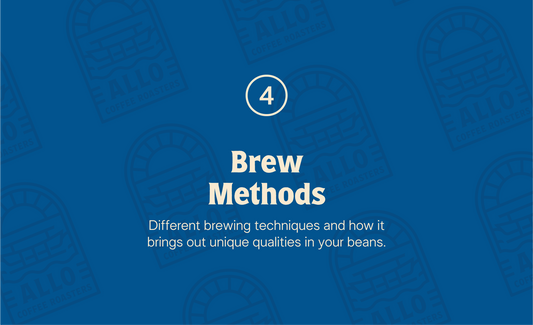I see, so you're already here. How quickly the student has become the master. Coffee Origins, Composition, Flavor Profiles, Processing Methods, and now Brew Methods. Going through our site, you'll notice that Grind Size is sorted by the equipment you'll use to make coffee, and that's exactly what we'll talk about.
Brew Methods

Above is our own guide that we've made to help you out! The brew method significantly affects how coffee tastes, because it controls key factors like extraction time, pressure, grind size, and water temperature. Each method pulls different compounds from the coffee grounds, which results in a unique flavor, mouthfeel, and strength.
- AeroPress
- Coffee Maker
- Cold Brew
- Espresso
- French Press
- Moka Pot
- Pour-over
A French Press is your rustic mashed potato: hearty, unfiltered, and full of grit. An espresso? That's your crunchy, golden fry. Cold brew? A slow, mellow stew that brings out the smooth, comforting side. The method alters texture, strength, mouthfeel, and flavor. These are the words people usually use to describe coffee. "Oh, it's a little sour," or "Hmmm, it's got a velvety feel," and even the infamous, "This one's bitter. Like, really bitter." And if it comes in a unassuming, tiny cup? That's that me, espresso.
Sensory Categories
Sensory Categories are the key elements we use to describe how coffee tastes and feels. They're not just fancy schmancy jargon. They help us break down the complex experience of drinking coffee into something easier to understand and compare. Whether you're new or seasoned, these'll help you choose beans and brew methods that suit your personal taste.

We've already discussed flavor notes in Taste Profiles and Flavor Notes, so let's expound on Mouthfeel, Acidity, Balance, and the scale between Sweetness and Bitterness.
Mouthfeel
Mouthfeel or Body is the texture and weight of the coffee in your mouth. It’s how the liquid "feels," like comparing skim milk to cream. Like evaporated milk to condensed milk.
-
- Light: Feels watery or tea-like. Often found in high-acid, floral coffees.
- Medium: Balanced, smooth mouthfeel — not too thick or thin.
- Full: Heavier, creamier, more coating on the tongue.
- Silky: Smooth and luxurious, often found in well-processed coffees.
- Velvety: Similar to silky, but richer and slightly heavier.
- Syrupy: Thick and sweet, like a dessert wine or molasses.
Acidity
Acidity in coffee isn't like stomach acid or pineapple enzymes eating you back. It's more like the brightness or sharpness you taste in fruit, like a zing.
-
- Low: Smooth, mellow; common in darker roasts or lower-altitude beans.
- Medium: Present but not sharp; balances sweetness and body.
- High: Bright, citrusy, sometimes tangy or sparkling.
Balance
Balance refers to how well the different sensory elements (acidity, sweetness, bitterness, etc.) are harmonized in the cup. A well-balanced coffee doesn't let any single note overpower the others — it's smooth, cohesive, and easy to drink.
-
- Well-Balanced: No single flavor dominates; smooth, harmonious taste.
- Bright-Balanced: Acidity is more noticeable but still pleasant.
- Sweet-Balanced: Sweeter notes stand out but don’t overwhelm.
- Bold / Heavy-Balanced: Richer, darker flavors are dominant but balanced by body or low acidity.
- Unbalanced (Not negative in specialty coffee!): One element, like acidity or fruitiness, stands out more — can be very exciting for experienced drinkers.
With that out of the way, we can now expound on the different Brewing Methods and their different flavor notes, mouthfeel, acidity, sweetness, bitterness, and balance.
Back to Brew Methods

AeroPress
AeroPress is a compact and versatile brewing device that uses air pressure to push water through coffee grounds. It's fast, easy to travel with, and great for experimentation. Because of its pressure-based extraction (though not as intense as espresso), it produces a rich and smooth cup with lower bitterness and a clean finish.
Taste Profile
-
- Acidity: Low
- Mouthfeel: Light-bodied to Medium
- Sweetness: Subtle Sweetness
- Bitterness: Low
- Balance: Smooth and Rounded
- Acidity: Low
Coffee Maker / Drip Machine
This is your standard electric brewer. You just load the grounds, add water, and hit a button. It brews large quantities with minimal effort. While not known for nuance, a good machine with quality beans can yield a pleasant, everyday cup.
Taste Profile
-
- Acidity: Low to Moderate
- Mouthfeel: Medium
- Sweetness: Mild
- Bitterness: Low
- Balance: Balanced and Mild
- Acidity: Low to Moderate

Cold Brew
Cold brew involves steeping coarse coffee grounds in cold water for 12–24 hours. We're usually left with 'cold brew concentrate' that is mixed with other ingredients so its not too strong. And because heat isn't involved, it extracts fewer bitter compounds, making it sweet and mellow.
Taste Profile
-
- Acidity: Very Low
- Mouthfeel: Syrupy or Full-bodied
- Sweetness: Naturally Sweet, Chocolatey
- Bitterness: Very Low
- Balance: Smooth and Mellow
- Acidity: Very Low
Espresso
Espresso is made by forcing hot water through finely-ground coffee under high pressure. It’s the base for drinks like lattes and cappuccinos, but it stands on its own as a short, concentrated shot. It delivers the most intense coffee experience in a tiny volume.
Taste Profile
-
- Acidity: Moderate to High
- Mouthfeel: Full-bodied, Thick Cream
- Sweetness: Caramel or Dark Chocolate Notes
- Bitterness: High
- Balance: Bold and Intense
- Acidity: Moderate to High
French Press
The French Press steps coffee grounds directly in hot water before pressing them down with a metal filter. This immersion method results in a thick, heavy-bodied cup because it doesn’t filter out oils and micro-grounds.
Taste Profile
-
- Acidity: Moderate
- Mouthfeel: Heavy-bodied, Textured
- Sweetness: Earthy Sweetness
- Bitterness: Mild to Moderate
- Balance: Rich and Bold
- Acidity: Moderate
Moka Pot
Also called a stovetop espresso maker, the Moka Pot brews by passing boiling water pressurized by steam through coffee grounds. It’s a strong, espresso-like cup, often used in European households.
Taste Profile
-
- Acidity: Low to Moderate
- Mouthfeel: Medium to Full-bodied
- Sweetness: Chocolatey or Nutty Undertones
- Bitterness: Noticeable, can be Sharp
- Balance: Intense and Strong
- Acidity: Low to Moderate
Pour-Over (V60, Kalita, etc.)
Pour-over is a manual brewing method where hot water is poured slowly over coffee grounds in a filter. It gives the most control over extraction and highlights the nuances of the coffee, making it a favorite for specialty brewers. This is also what you mostly see YouTubers use, and they look like science experiments.
Taste Profile
-
- Acidity: High
- Mouthfeel: Light to Medium
- Sweetness: Clean and Crisp
- Bitterness: Low
- Balance: Bright and Delicate
- Acidity: High
It's kinda like potatoes, I think.
You stick them, mash them, put them in a stew. Fry them too much, they get crunchy and even burnt. Boil them for long, they become buttery and smooth. Same goes for coffee. No matter how high-quality the bean, how it’s brewed plays a massive role in shaping the final cup. Brew it one way, and you’ll pull out its brightness and clarity. Brew it another way, and you’ll drown it in oils, body, or even bitterness. It’s not about right or wrong, it’s about what you’re going for, and what kind of drinking experience you want. Some just want their really coffee bitter and some prefer it sweet (along with milk and sugar), and that's okay!
Allo, Out! For the last time.
Hey, you, you're finally an Allo Coffee Roasters® Certified Coffee Enthusiast (ACRCCE). Some would say that's contestable, that this entire curriculum (four articles) isn't enough to certify someone as a coffee enthusiast. Don't listen to them. We see you, and maybe that's all you need. Love you for you, man. Call it bitter, too bitter, or 'Hey, I'm sensing a bit of Black Forest Cake in this coffee as a flavor note. It's kind of giving that Allo Coffee Roaster's First Tide Blend I drank last month." At the very least, you kinda know what's going on with coffee now. We've given you a starting kit of knowledge, and now the rest is up to you. Smell the coffee, taste the coffee, make the coffee. The world is your coffee bean, let's see how you roast it. Uh, process it? Brew it? Coffee!
As congratulations for finishing the four articles, we wholeheartedly (with a caffeine-sped up heart) present you with the Allo Coffee Roasters® Certified Coffee Enthusiast (ACRCCE).

Please note that this is not an internationally or institutionally recognized certification, and this would probably have no value being displayed on your LinkedIn Profile. But if you come to our shop and tell us you've read everything, then we'd probably give you a thumbs up and a smile.









